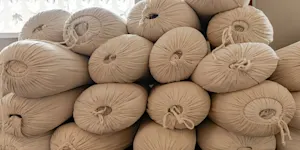What Makes This Word Tick
"Cretonne" has a delightful rhythm to it, don't you think? It's a type of heavy fabric with a strong utility for upholstery and curtains. Its durability and affordability make it a staple in homes that value both style and longevity. Think florals and bold patterns, making spaces lively and welcoming.
If Cretonne Were a Person…
Cretonne would be that hearty aunt with an artistic flair, always the first to repaint a room or reupholster her own furniture. She loves a good pattern mix and has a knack for making a house feel like a home. Her charm lies in her practicality wrapped in a layer of creativity.
How This Word Has Changed Over Time
Once just a fabric name, "cretonne" has become synonymous with homespun charm. It conjures images of quaint sitting rooms from decades past. Though its usage has waned with modern minimalism, it still holds a nostalgic spot in home decor vocabulary.
Old Sayings and Proverbs That Use Cretonne
While no age-old tales feature cretonne directly, imagine replacing "home" in "home is where the heart is" with cretonne—and you'll get the picture of coziness and warmth this fabric represents.
Surprising Facts About Cretonne
This fabric was originally made from linen or hemp, but as times changed, so did its composition; today, cotton reigns supreme. Surprisingly, despite its hefty appearance, cretonne’s lightness makes it an easy choice for curtains.
Out and About With This Word
Ever notice how antique shops and vintage markets have those vividly patterned armchairs? Chances are, cretonne is the star of the show. In these shops, history buffs and dreamers rub elbows with this fabric, reliving days of simpler, tactile pleasures.
Pop Culture Moments Where Cretonne Was Used
Cretonne had its heyday in the backdrop of classic films set in mid-century homes. From 1950s family sitcoms to 1960s dramas, the fabric's flourishes helped set the scene in countless kitchens and living rooms.
The Word in Literature
In literature, cretonne might be draped over characters' lives, signifying both comfort and the mundane. It’s the kind of detail you’d expect from a descriptive passage in a historical novel, painting the family home’s vivid interior life.
Moments in History with Cretonne
During Victorian times, cretonne helped democratize decor, allowing the middle-class to indulge in opulent home design without breaking the bank. Imagine bustling parlors of the era, filled with chatter, cretonne emphasizing the social status of its owners.
This Word Around the World
In France, cretonne carries its origin story proudly. The fabric's mass appeal there set the stage for its spread across Europe and beyond, becoming a universal symbol of durable, affordable style. Its name, originating from the French town of Creton, rings with global recognition.
Where Does It Come From?
Cretonne takes its name from a small town in Normandy, France, known as Creton. Initially a heavy linen fabric, it evolved through the ages, just like the communities that first embraced it.
How People Misuse This Word
People sometimes confuse cretonne with simple printed cotton or even chintz, though its durability and utility for upholstery set it apart. It’s not just any patterned fabric; it’s built for a bit of rugged beauty.
Words It’s Often Confused With
Chintz: Both have bold patterns, but chintz has a glazed finish.
Damask: Similarly ornate, but damask often has a more formal, woven pattern.
Twill: Another strong fabric, but twill is characterized by a diagonal weave.
Additional Synonyms and Antonyms
Synonyms include muslin and chintz for their similar use in decoration, while its antonyms might be silks or satins, which lean more towards luxury and less towards utility.
Want to Try It Out in a Sentence?
"After inheriting her grandmother's beloved house, Lucy couldn't bring herself to change a thing, leaving the cretonne drapes swaying softly in the summer breeze."
















